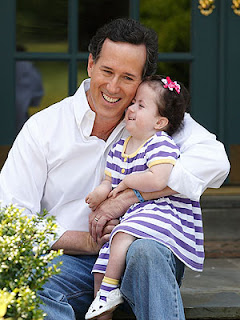Defies odds with Trisomy 18 by Santorum's daughter
At age 3, Rick Santorum’s daughter Bella, who has been hospitalized for the second time during his presidential campaign, has outlived the majority of children born with Trisomy 18, a relatively common chromosomal defect that occurs in one out of every 3,000 to 5,000 live births and is three times more common in girls than boys.
Children with Trisomy 18, also known as Edwards syndrome, have three copies of chromosome 18, instead of the normal two, in their cells. Many pregnancies with affected fetuses miscarry, and half of all affected babies who are carried to term will be stillborn, according to the Trisomy 18 Foundation. Most cases aren’t inherited but occur as a random error in cell division during the formation of eggs and sperm, according to the National Library of Medicine.
About 5 percent to 10 percent of children with Trisomy 18 survive the first year of life, and they often have severe intellectual disability, according to the library, part of the National Institutes of Health.
“They usually die from inability to breathe,” says Dr. Larry Fenton, director of pediatric palliative care at Sanford Children’s Hospital in Sioux Falls, S.D. “The mechanism of the brain telling the lungs to expand frequently is defective.”
Still, “while the developmental disability in children with Trisomy 18 … is significant, it is important to recognize that children do advance to some degree in their milestones,” Dr. John Carey, a pediatric geneticist at the University of Utah Health Sciences Center, writes on the Trisomy 18 Foundation’s website. “They can interact with their families, smile and acquire some skills, such as rolling over, self-feeding, etc., if they survive infancy.”
The reason for Bella's current hospitalization hasn't been released.
"Rick and his wife Karen have taken their daughter Bella to the hospital. The family requests prayers and privacy as Bella works her way to recovery," Santorum Communications Director Hogan Gidley said in a statement.
In January, she was rushed to a hospital in Virginia when she developed double pneumonia.
A small number of children with Trisomy 18, usually girls, live into their 20s and 30s, according to the foundation. However, the organization says, they have “significant developmental delays that do not allow them to live independently without assisted caregiving.”
Those who do survive beyond their first year usually can’t talk or walk and need some sort of a feeding tube in order to get nourishment, Fenton says. Although they are able to breathe, they’re likely to die eventually of pneumonia or other infections, he says. Largely it’s because they spend a lot of time in bed. "They don’t do the kinds of things that help clear the lungs, so they are much more vulnerable to infections.”
Recently, Fenton says, he met a 30-year-old woman with Trisomy 18, the oldest person he’d ever met with the disorder. “I would have to say she was profoundly disabled on the one hand and beautiful on the other. She was impeccably dressed. She had makeup on. She clearly knew her mom and dad and could reach out to them.”


Comments
Post a Comment